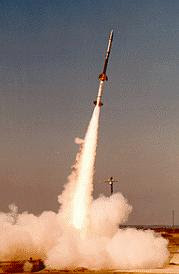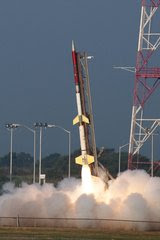On a brisk morning under cloudy skies, about 200 people — many carrying a long-stemmed rose — gathered at the stark Space Mirror Memorial at the front of the tourist attraction for the service sponsored by the Astronauts Memorial Foundation. By the end of the 45-minute ceremony, the skies were as clear as they were a quarter-century ago when Challenger exploded.
Bill Gerstenmaier, NASA's associate administrator for Space Operations, said he had vowed after the Challenger explosion that it would never happen again. But it did – on Feb. 1, 2003 – when shuttle Columbia broke up on re-entry because a piece of insulating foam falling off the fuel tank had punched a hole in the orbiter's wing during launch.
Like the cause of the Challenger disaster – caused by a failed O-ring in the shuttle's solid-rocket booster – problems with foam coming off the tank were apparent after the shuttle's first flight in 1981, he said. But NASA engineers didn't judge them serious enough to halt flights to fix them.
 "This is the most difficult speech that I give," Gerstenmaier said. "This speech becomes much more than words as I reflect on the failings of the human safe-flight team…They're not academic or simple lessons, but are lessons that must be implemented and learned every day. The little things that seemed harmless can become catastrophic events."
"This is the most difficult speech that I give," Gerstenmaier said. "This speech becomes much more than words as I reflect on the failings of the human safe-flight team…They're not academic or simple lessons, but are lessons that must be implemented and learned every day. The little things that seemed harmless can become catastrophic events."However, he added, "We can't let the fear of failure stop us from the challenges and risky work of discovery."
Gerstenmaier was joined by June Scobee Rodgers, widow of Challenger's commander, Dick Scobee. But unlike the veteran NASA administrator, she chose to emphasize the positive – creation of the Challenger Centers that have provided 4 million students in the U.S .as well as in Canada, South Korea and Canada with space-education programs.
"What should have been a day of education turned to tragedy in a split second," said Scobee Rodgers, who has remarried.
"Lessons were left untaught," she said, adding that the families of the dead crewmembers – including Christa McAuliffe, the New Hampshire high-school teacher who was flying as part of the Teacher in Space program -- realized that "if we didn't somehow continue Challenger's mission of education, then our loved ones would have died in vain."
 In a statement released before the event, Steven McAuliffe, Christa McAuliffe's widower, put it like this: "Ordinary people can make extraordinary contributions when they remain true to themselves and enthusiastically pursue their own dreams wherever they may lead."
In a statement released before the event, Steven McAuliffe, Christa McAuliffe's widower, put it like this: "Ordinary people can make extraordinary contributions when they remain true to themselves and enthusiastically pursue their own dreams wherever they may lead."In addition to McAuliffe and Scobee, the Challenger crew included pilot Michael Smith, astronauts Ronald McNair, Judith Resnik, Ellison Onizuka and payload specialist Gregory "Bruce" Jarvis, who worked for Hughes Aircraft Co.
The theme of the day was the legacy of the seven astronauts who lost their lives just 73 seconds into the flight. It was a message focusing on learning not loss.
The shuttle was destroyed 73 seconds after launch, when a failed O-ring in one of the shuttle's solid-rocket boosters allowed hot gases to escape and ignite the shuttle's main fuel tank. It was the 25th flight in the shuttle program.
A quarter-century later, images of the exploding space shuttle still signify all that can go wrong with space travel.
The accident — the first high-tech catastrophe to unfold on live TV — took place 9 miles above the Atlantic and remains NASA's most visible failure. Adding to the anguish was the young audience: Schoolchildren everywhere tuned in to watch McAuliffe become the first schoolteacher and ordinary citizen bound for space.
President Ronald Reagan was due to give his State of the Union address the night of the Challenger disaster. Instead he postponed the speech for a week, and appeared on national television to pay tribute to the crew.
He said they were "pioneers" before ending his address with two lines from the John Magee poem "High Flight": "We will never forget them, nor the last time we saw them, this morning, as they prepared for their journey and waved goodbye and 'slipped the surly bonds of earth' to 'touch the face of God'
www.wtkr.com




 The rocket was launched as part of a Navy exercise off the mid-Atlantic coast. Three U.S. Second Fleet ships, including the U.S.S. Monterrey, the U.S.S. Ramage and the U.S.S. Gonzalez, converged off the Atlantic coast just south of Assateague to test their tracking systems for the Aegis Ballistic Missile Defense (BMD) system. All three successfully tracked the sub-orbital Terrier Oriole rocket launched from Wallops early last Saturday morning.
The rocket was launched as part of a Navy exercise off the mid-Atlantic coast. Three U.S. Second Fleet ships, including the U.S.S. Monterrey, the U.S.S. Ramage and the U.S.S. Gonzalez, converged off the Atlantic coast just south of Assateague to test their tracking systems for the Aegis Ballistic Missile Defense (BMD) system. All three successfully tracked the sub-orbital Terrier Oriole rocket launched from Wallops early last Saturday morning.







 The first Taurus II mission, under a NASA Commercial Orbital Transportation Services agreement, will be a risk reduction test flight, followed by a demonstration mission to show the vehicle's capability to perform the commercial re-supply missions, which are slated to begin in early 2012.
The first Taurus II mission, under a NASA Commercial Orbital Transportation Services agreement, will be a risk reduction test flight, followed by a demonstration mission to show the vehicle's capability to perform the commercial re-supply missions, which are slated to begin in early 2012.











